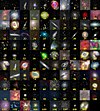Rosette nebula
| Emission nebula | |
|---|---|
| Data of the Rosette Nebula
|
|

|
|
| AladinLite | |
| Constellation | unicorn |
|
Position equinox : J2000.0 , epoch : J2000.0 |
|
| Right ascension | 06 h 30 m 42.0 s |
| declination | + 05 ° 01 ′ 00 ″ |
| Appearance
|
|
| Apparent brightness (visual) | 6.0 likes |
| Angular expansion | 80.0 '× 60.0' |
| Ionizing source | |
| designation | NGC 2244 |
| Type | Open star cluster |
| Physical data | |
|
history
|
|
| discovery | John Flamsteed John Herschel Albert Marth Lewis A. Swift |
| Date of discovery | February 17, 1690 March 1830 February 28, 1864 1865 February 27, 1886 |
| Catalog names | |
| NGC 2237-2239 • NGC 2244 • NGC 2246 • Cr 99 • Mel 47 • OCl 515 • Caldwell 50 • h 392 • GC 1420 | |
The Rosette Nebula is a diffuse emission nebula with embedded open star clusters in the constellation Unicorn .
The nebula has a size of 80.0 '× 60.0' and an apparent magnitude of 6.0 mag. Today, the NGC objects designate NGC 2237 (observation by Lewis A. Swift of 1865), NGC 2238 (observation of Albert Marth of February 28, 1864), NGC 2239 (observation of John Herschel of March 1830) and NGC 2246 (observation of Lewis A. Swift February 27, 1886) various parts of the nebula. Historically, the four numbers denoted slightly different star clusters and nebulae in this area.
In the center of the nebula is the open star cluster NGC 2244 = (NGC 2239) (observation by John Flamsteed on February 17, 1690), which makes the nebula shine . The star cluster has an apparent magnitude of 4.8 mag and a diameter of 24 '.
See also
Web links
- Rosette Nebula in the NGC Interactive Database
- Rosette Nebula Information at the Anglo-Australian Observatory
- Spektrum.de : Amateur recordings [1] [2] [3] [4]

